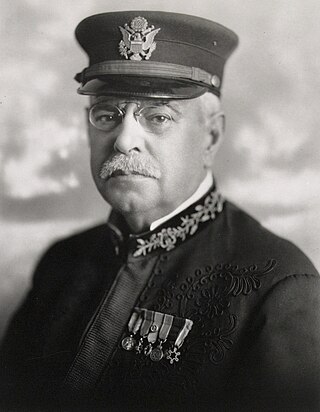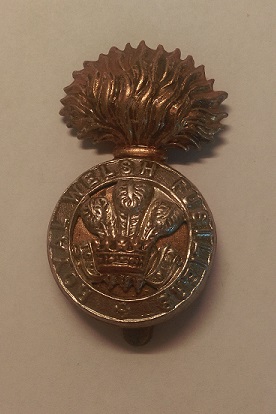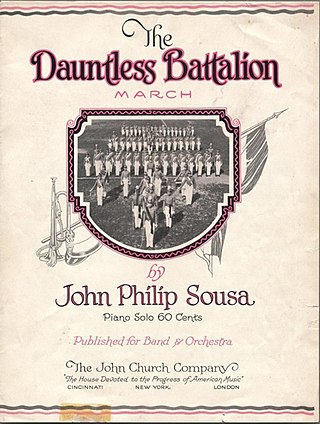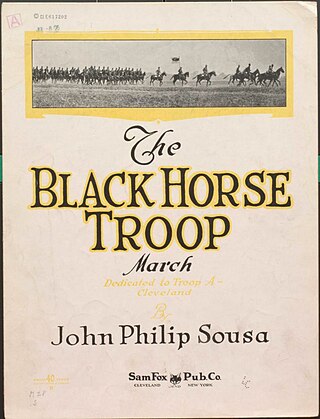
John Philip Sousa was an American composer and conductor of the late Romantic era known primarily for American military marches. He is known as "The March King" or the "American March King", to distinguish him from his British counterpart Kenneth J. Alford. Among Sousa's best-known marches are "The Stars and Stripes Forever", "Semper Fidelis", "The Liberty Bell", "The Thunderer", and "The Washington Post".

The Royal Welch Fusiliers (Welsh: Ffiwsilwyr Brenhinol Cymreig) was a line infantry regiment of the British Army, and part of the Prince of Wales's Division, that was founded in 1689; shortly after the Glorious Revolution. In 1702, it was designated a fusilier regiment and became the Welch Regiment of Fusiliers; the prefix "Royal" was added in 1713, then confirmed in 1714 when George I named it the Prince of Wales's Own Royal Regiment of Welsh Fusiliers. In 1751, after reforms that standardised the naming and numbering of regiments, it became the 23rd Regiment of Foot (Royal Welsh Fuzileers). In 1881, the final title of the regiment was adopted.

A bearskin is a tall fur cap derived from mitre caps worn by grenadier units in the 17th and 18th centuries. Initially worn by only grenadiers, its usage was extended to several other military units in the 19th century. The bearskin cap continued to see use in battle during the mid-19th century, although by the 20th century, its use was limited as a headgear reserved for parade dress. In the 21st century, the bearskin cap is retained by select military units as a prominent element of their ceremonial and full dress uniforms.

Frederick Joseph Ricketts was an English composer of marches for band. Under the pen name Kenneth J. Alford, he composed marches which are considered to be great examples of the art. He was a Bandmaster in the British Army, and Royal Marines Director of Music. Conductor Sir Vivian Dunn called Ricketts "The British March King". Ricketts' frequent use of the saxophone contributed to its permanent inclusion in military bands. His best known work is the "Colonel Bogey March".

The Royal Welsh is an armoured infantry regiment of the British Army. It was established in 2006 from the Royal Welch Fusiliers and the Royal Regiment of Wales.

The United States Marine Band is the premier band of the United States Marine Corps. Established by act of Congress on July 11, 1798, it is the oldest of the United States military bands and the oldest professional musical organization in the United States. Today, the Marine Band includes the Marine Chamber Orchestra and Marine Chamber Ensembles.

Claudio S. Grafulla (1812–1880) was a composer in the United States during the 19th Century, most noted for martial music for regimental bands during the early days of the American Civil War.

“The Minnesota March” is a march for wind band written by John Philip Sousa in 1927 for the University of Minnesota. Sousa received an informal request for the march from Minnesota football coach Clarence Spears, and agreed to a request from a committee of university officials in October 1926. Sousa used Indian themes in this march, and later added field drum and bugle parts. The march was published by the Sam Fox Publishing Company and was premiered by Sousa and his band on September 3, 1927 at the Minnesota State Fair. It was first performed at the University of Minnesota the next month, on October 26, with a performance by the university band.
The Gallant Seventh is a march composed by John Philip Sousa in 1922 whilst recovering from a broken neck. The march takes its name from the 7th Regiment of the New York National Guard. The conductor of the Regiment band was Major Francis Sutherland, a former cornetist in Sousa's own civilian band.
"The Thunderer" is a march composed by John Philip Sousa in 1889. The origin of the name is not officially known, though it is speculated that the name is attributed to Myron M. Parker, a prominent DC politician and Freemason. It is also one of Sousa's most famous compositions.
The 158th Infantry Brigade was an infantry brigade of the British Army that served in both the First and Second World Wars, before being disbanded in 1968. Throughout its existence the brigade was assigned to the 53rd (Welsh) Infantry Division and was composed almost entirely of Territorial battalions from the Royal Welch Fusiliers.

The following is a list of the notable Regimental Marches for military regiments of the British Army. In addition, all regiments have additional pieces for slow marches, marches for mounted parades and pipe marches.

"Anchor & Star" is an American military march composed by John Philip Sousa in 1918, while he served as leader of the U.S. Navy Battalion Band at the Great Lakes Naval Training Center during the First World War.

"Columbia's Pride" is a patriotic American march composed by John Philip Sousa in 1914, based on his 1890 song, "Nail the Flag to the Mast." "Columbia's Pride" was published in 1914 by Theodore Presser Co. in Philadelphia as a score for piano.

"Imperial Edward" is an American military march composed in 1902 by John Philip Sousa, and dedicated to Edward VII, King of the United Kingdom. Sousa received permission to dedicate the march to Edward VII during a conversation with the royal family after his command performance concert at Sandringham on December 1, 1901. The march was premiered by Sousa's band in Montreal on May 21, 1902. Sousa would later conduct the piece for King Edward in January 1903, during a performance at Windsor Castle.

"The Dauntless Battalion" is an American military march by John Philip Sousa, published in 1922 and dedicated to the faculty and cadets of the Pennsylvania Military College (PMC) in Chester, Pennsylvania, known since 1972 as Widener University. Sousa received an honorary Doctor of Music degree from the college in February 1920. Ohio senator and future president Warren G. Harding was also honored with an honorary degree.

Stephen Bulla is an American composer and musician best known compositions for the United States Marine Band and The Salvation Army.

"The Black Horse Troop" is an American military march composed by John Philip Sousa in 1924 and published in 1925. It was dedicated to Troop A - Cleveland of the Ohio National Guard, today the 107th Cavalry Regiment. Sousa's first connection with Troop A was in 1881, when he marched with the unit as leader of the U.S. Marine Band in the funeral cortege of President James A. Garfield.















